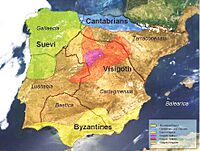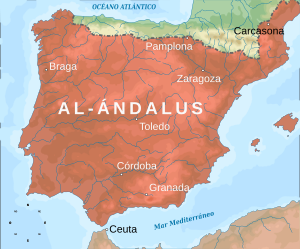Hispania facts for kids
Quick facts for kids
Hispania
|
|||||||||||||
|---|---|---|---|---|---|---|---|---|---|---|---|---|---|
| 218 BC–472 | |||||||||||||
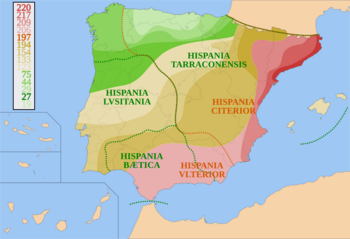
Timeline of the Roman conquest of Hispania (220 BC–19 BC), with Roman provincial boundaries shown
|
|||||||||||||
| Capital | |||||||||||||
| Common languages | Latin, various Paleohispanic languages | ||||||||||||
| Religion | Traditional indigenous and Roman religion, followed by Christianity | ||||||||||||
| Government | Autocracy | ||||||||||||
| Emperor | |||||||||||||
|
• AD 98 – AD 117
|
Trajan | ||||||||||||
|
• AD 117 – AD 138
|
Hadrian | ||||||||||||
|
• AD 379 – AD 395
|
Theodosius I | ||||||||||||
| Legislature | Roman Senate | ||||||||||||
| Historical era | Classical antiquity | ||||||||||||
|
• Established
|
218 BC | ||||||||||||
|
• Disestablished
|
472 | ||||||||||||
| Population | |||||||||||||
|
•
|
5,000,000 or more | ||||||||||||
|
|||||||||||||
Hispania was the name the Romans gave to the land we now call the Iberian Peninsula. This area includes modern-day Spain and Portugal. It was a very important part of the Roman Empire for over 600 years.
At first, the Romans divided Hispania into two main areas: Hispania Citerior (closer to Rome) and Hispania Ulterior (further away). Over time, as the Roman Empire grew and changed, Hispania was divided into many smaller provinces. The name Hispania was even used later during the time of the Visigothic Kingdom. Today, the names Spain and Hispaniola (an island in the Caribbean) come from Hispania.
Contents
What Does "Hispania" Mean?
The exact meaning of the word Hispania is a bit of a mystery! Many people have tried to figure it out.
Theories About the Name
One popular idea is that the name comes from the Phoenician language. The Phoenicians were ancient traders who visited the area. They might have called it something like 'island of the hyrax'. A hyrax is a small animal, but the Phoenicians might have mistaken the European rabbit for it. Some old Roman coins even show Hispania with a rabbit!
Another idea from Phoenician is that Hispania meant 'hidden' or 'far-distant land'. This would make sense because it was far to the west of their homeland.
Some scholars thought the name came from an older local word, perhaps from the city of Seville, which was called Hispalis. Others thought it might be from a Basque word meaning 'border' or 'edge'.
There's also a legend that the name came from a hero named Hispan, mentioned by a Roman historian long ago.
How "Hispania" Became "Spain"
The word Hispania is the root for the modern name Spain. However, the words weren't always used in the same way. For a long time, Hispania referred to the whole peninsula.
Around the 13th century, during the Reconquista (a long period when Christian kingdoms took back land from Muslim rulers), people started using words like España (in Spanish) and Espanya (in Catalan) to talk about the area.
Even in the Middle Ages, writers praised Hispania. For example, Isidore of Seville wrote about Hispania as a "holy and always happy mother of princes and peoples," calling it "the most beautiful of all lands." He even said that "golden Rome desired you."
Over many centuries, especially after the kingdoms of Castile and Aragon united in 1492, the name "Spain" became more and more linked to the modern country we know today.
Life Before the Romans Arrived
The Iberian Peninsula has been home to people for a very long time!
Early Humans and Ice Ages
Long, long ago, early humans like Homo erectus and Neanderthals lived here. Around 40,000 years ago, modern humans arrived. They were nomadic hunter-gatherers. During the last ice age, many people took shelter in southern Iberia. They created amazing pre-historic art, like the cave paintings found in places like L'Arbreda Cave.
Farming and New Cultures
After the ice age, around 10,000 BC, the climate got warmer. People who had taken shelter in Iberia spread out and recolonized Western Europe.
Around 5,000 BC, big changes happened with the start of the Neolithic period. People began to farm, and the European Megalith Culture started, building huge stone structures.
Later, in the Bronze Age, people who spoke Indo-European languages moved into Iberia. Then came the Celts. Important cities and cultures developed in the south, like Tartessos. The Phoenicians and Greeks also set up trading posts along the coast, bringing new ideas and ways of life.
Languages Spoken in Hispania

When the Romans ruled Hispania for over 600 years, Latin became the official language. By the time the Roman Empire ended around 460 AD, most of the original Iberian languages had disappeared. Only the language that led to modern Basque survived.
Even after the Roman Empire fell and Germanic tribes like the Visigoths arrived, most people still spoke a form of Latin. This everyday Latin, called Vulgar Latin, slowly changed over time, leading to the modern Iberian Romance languages like Spanish and Portuguese.
Carthaginian Influence in Hispania
Before the Romans, another powerful group, the Carthaginians, had a strong presence in Hispania. After they lost a big war against the Romans (the First Punic War), Carthage focused on building a new trading empire in Hispania.
Many of the Punic Wars (wars between Carthage and Rome) were fought on the Iberian Peninsula. After losing the Second Punic War, Carthage had to give control of Hispania to Rome in 201 BC. This is how Rome became the main power in the Mediterranean area. The Romans even adopted the Carthaginian name for the land, changing it to Hispania.
Roman Conquest and Rule
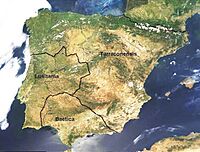
Roman armies first arrived in the Iberian Peninsula in 218 BC. They used Hispania as a place to train soldiers and try out new battle plans against the Carthaginians and local tribes like the Iberians and Lusitanians.
It took a long time for Rome to fully conquer Hispania. It wasn't until 19 BC, when Emperor Augustus was in charge, that the conquest was complete after the Cantabrian Wars. Before that, many parts of Hispania were still independent.
Becoming Roman
Life in Hispania changed a lot under Roman rule. This process, called Romanization, meant that people started to adopt Roman ways of life, language, and laws. Some areas became Roman very quickly, while others took longer.
Hispania became a key part of the Roman Empire for 500 years. It was connected by Roman laws, the Latin language, and a network of Roman roads. Even Roman soldiers who lived there started to feel like hispanici (Hispanic).
Some people from Hispania even became part of the Roman government and helped rule the empire. Large farms called latifundia, owned by wealthy Romans, were set up.
The Romans improved existing cities like Lisbon (called Olissipo) and Tarragona (called Tarraco). They also built new cities like Zaragoza (Caesaraugusta), Mérida (Augusta Emerita), and Valencia (Valentia).
Hispania's Economy
Under Roman rule, Hispania's economy grew a lot. It became a major source of food and metals for the Roman market. Its ports exported valuable goods like gold, tin, silver, lead, wool, wheat, olive oil, wine, and fish. Farmers used new irrigation systems, some of which are still used today!
By the end of the 1st century AD, many people born in Hispania, including descendants of Roman soldiers, became full Roman citizens. Some famous Roman emperors, like Trajan, Hadrian, and Theodosius I, were actually from Hispania!
Dividing Hispania
At first, Hispania was divided into two provinces: Hispania Citerior (closer) and Hispania Ulterior (further). The border ran from Cartago Nova to the Cantabrian Sea.
- Hispania Ulterior included parts of modern-day Andalusia, Portugal, Extremadura, León, Galicia, Asturias, and the Basque Country.
- Hispania Citerior included parts of Castilla la Vieja, Aragon, Valencia, and Catalonia.
In 27 BC, Emperor Augustus made new divisions:
- Hispania Baetica: Its capital was Corduba. It covered most of modern Andalusia.
- Lusitania: Its capital was Emerita Augusta (now Mérida). It included much of modern Portugal.
- Tarraconensis: Its capital was Tarraco (Tarragona). This was the largest province, covering northern and eastern Spain, including Gallaecia (modern Galicia) and Asturias.
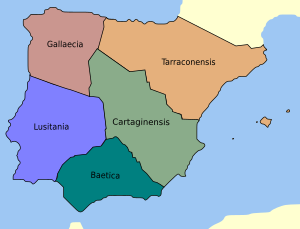
Later, around 293 AD, the Roman Empire was reorganized. Hispania became a "diocese" (a large administrative area) with its capital at Mérida. This diocese included the five main Iberian provinces, the Balearic Islands, and even a part of North Africa called Mauretania Tingitana.
Christianity in Hispania
Christianity arrived in Hispania in the 1st century AD and became popular in cities by the 2nd century. By the late 4th century, it was the official religion of the Roman Empire. When the Roman government started to weaken in the 5th century, local bishops (church leaders) helped keep order.
Germanic Tribes Arrive
The end of Roman rule in Hispania began in 409 AD when several Germanic tribes and the Sarmatian Alans moved into the peninsula.
New Kingdoms Form
- The Suevi tribe set up a kingdom in Gallaecia (modern Galicia and northern Portugal).
- The Alans created a kingdom in Lusitania.
- The Silingi Vandals briefly took over parts of southern Hispania.
The Romans tried to get the region back. They even asked the Visigoths, another Germanic tribe, for help. The Visigoths helped defeat some of the invaders.
In 429 AD, the Vandals and Alans crossed into North Africa, which was a big event that sped up the decline of the Western Roman Empire. After they left, the Romans regained much of Hispania, but only for a short time.
The Visigothic Kingdom
The Visigoths eventually took control of most of Hispania. In 484 AD, they made Toledo the capital of their kingdom. Visigothic kings ruled Hispania, often seeing themselves as governing on behalf of the Roman emperor. By 585 AD, the Visigoths had conquered the Suebic Kingdom, controlling almost all of Hispania.
Under the Visigoths, education and government shifted more to the Church. The clergy (church officials) became very important in managing the administration. The Church was the most organized group in society. The Visigoths also brought mainstream Christianity to the peninsula.
One big problem was that the Visigothic rulers were Arian Christians, while most of the local Hispano-Romans were Catholic. This caused tension. However, in 589 AD, the Visigothic king Recared became Catholic, which helped unite the Visigoths and the Hispano-Romans.
Even with this unity, the Visigothic kingdom faced many problems like civil wars and assassinations. This made it easier for outside groups to get involved in their disputes.
The Umayyad Conquest
In 711 AD, a Muslim army led by Tariq ibn Ziyad crossed from North Africa into southern Hispania. They defeated the Visigothic army in a major battle. Within a few years, they took control of more than two-thirds of the Iberian Peninsula.
The Muslims called the area they controlled 'Al-Andalus'. This region was divided into five administrative units. For a long time, the Christian kingdoms in the north continued to use names like Spania or España to refer to the Muslim-controlled areas.
The Christian Reconquest
From the mid-13th century onwards, the only part of Al-Andalus still under Muslim rule was the Emirate of Granada. This changed with the War of Granada, which ended in 1492 when Granada was taken by the Christian kingdom of Castile. This marked the end of Islamic rule on the Iberian Peninsula.
By the late 12th century, the whole Iberian Peninsula, both Muslim and Christian parts, became known as "Spain." People often talked about "the Five Kingdoms of Spain," which included the Muslim Kingdom of Granada and the Christian kingdoms of Aragon, Castile, Portugal, and Navarre.
Economy in Roman Hispania
Before the Romans and Carthaginians arrived, Hispania had lots of untapped natural resources, but its people mostly lived by farming just enough to survive.
When the Carthaginians and then the Romans took over, they developed Hispania's economy, especially for its rich silver deposits. Hispania became a busy place for trade. It produced and exported many goods across the Roman Empire, including various metals, olives, olive oil, salted fish, and wines. Gold mining was very important in the northwest, as seen at places like Las Médulas.
Climate in Ancient Hispania
The climate in Roman Spain had its ups and downs. There were periods with a lot of rain, especially between 550 BC and 190 BC, and again from 150 AD to 350 AD. There was also a drier period in between.
Sometimes it was extremely hot. For example, in 134 BC, a Roman army had to march at night because of the heat, and some of their animals died of thirst. Other times, heavy spring rains could stop armies from fighting. Temperatures changed over the centuries, sometimes warm, sometimes cooler.
Images for kids
-
Archaeological Roman Ensemble of Mérida (Emerita Augusta), Extremadura, Spain.
-
The Roman Tower of Hercules is the oldest surviving Roman lighthouse.
-
The Roman Aqueduct of Segovia, Castile, Spain.
 In Spanish: Hispania para niños
In Spanish: Hispania para niños
- List of Roman sites in Spain
- Pre-Roman peoples of the Iberian Peninsula
- Iberian peninsula
- Carthaginian Iberia
- Iberian languages (all languages spoken, past & present, in Iberia)
- Tartessos (Early Iberian civilization)
- Tartessian language
- Southwest script
- Ophiussa
- Iberians
- Iberian language
- Iberian scripts
- Lusitanians
- Lusitanian language
- Lusitanian mythology
- Cynetes
- Celtiberians
- Celtiberian language
- Celtiberian script
- Hispania Citerior
- Hispania Ulterior
- Tarraconensis
- Lusitania
- Gallaecia
- Baetica
- Suevi Gallaecia
- Vandals in Hispania
- Alans in Hispania
- Visigothic Hispania
- Al-Andalus (Muslim Medieval Iberia)
- Umayyad conquest of Hispania
- Timeline of the Muslim Occupation of the Iberian peninsula
- History of Andalucía
- Reconquista
- Portugal
- History of Portugal
- Timeline of Portuguese history
- Spain



